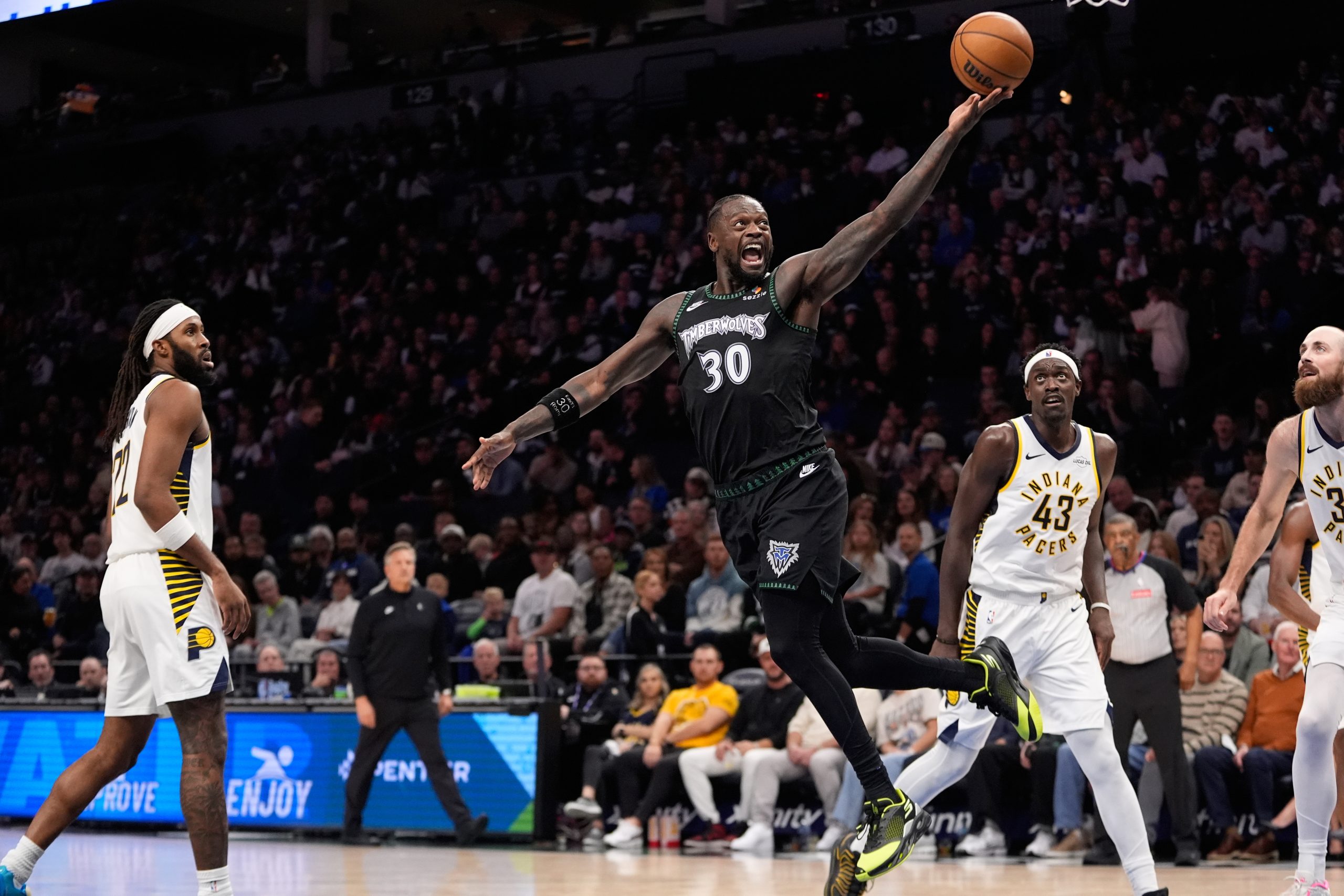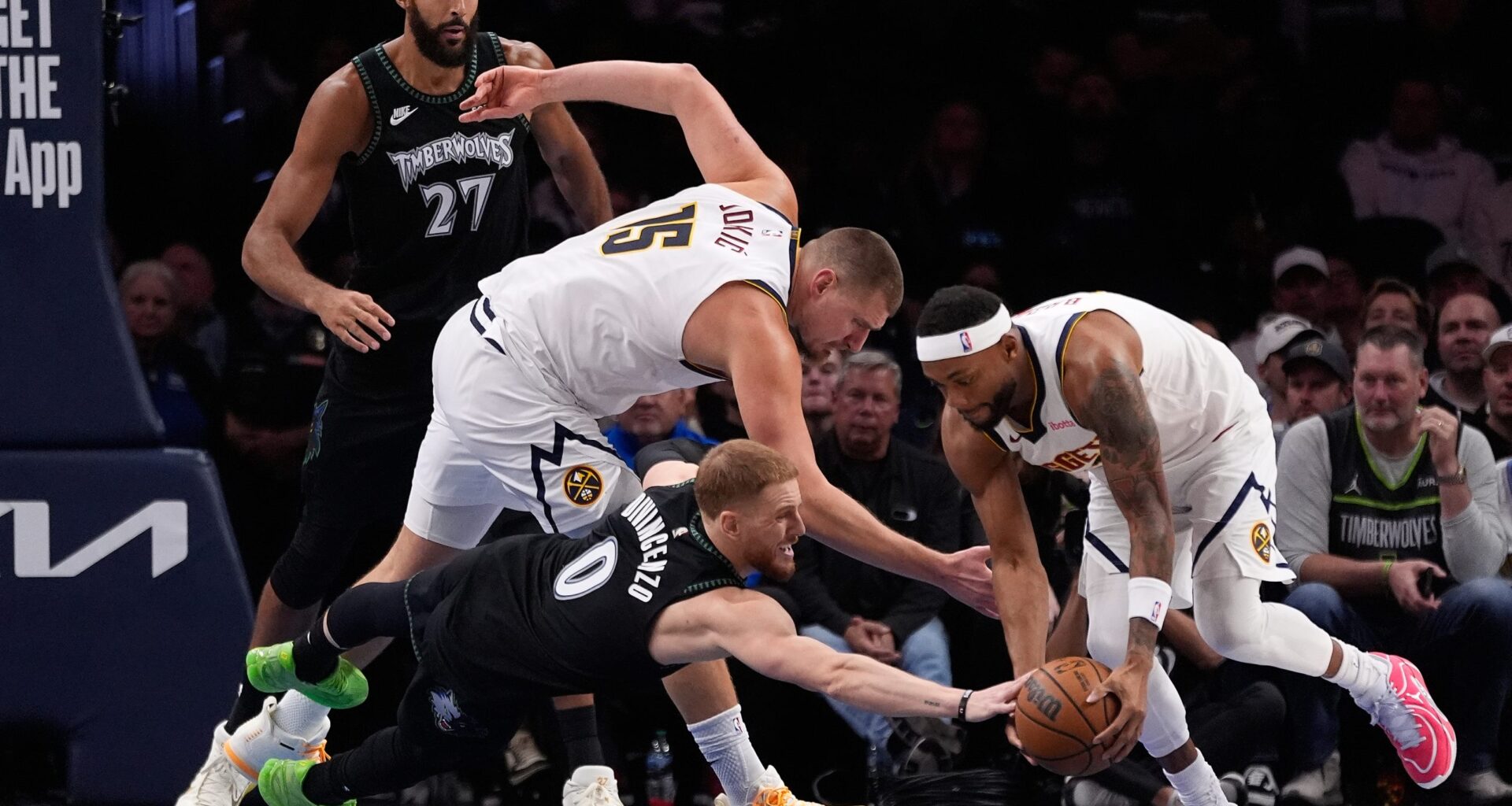One week into the 2025-26 NBA season, the Minnesota Timberwolves are an ordinary team in an extraordinary conference.
In the three years that Head Coach Chris Finch and President of Basketball Operations Tim Connelly have been paired as progenitors of the playbook and personnel, respectively, the Wolves have been defined by their defense. They have ranked 10th, then first, and then sixth among the 30 NBA teams in fewest points allowed per possession.
A week into this season, Minnesota is 27th in “fewest” points allowed per possession. In the two games they have played against opponents expected to make the playoffs in the brutally competitive Western Conference, they have been roasted as a result of their woefully slow rotations and sapped of sweat equity as their foes toy with their ineptitude with joyful arrogance.
Two seasons ago, the Wolves top-rated defense would emerge from the locker room at halftime and suffocate opponents into submission. They allowed just 103.4 points per 100 possessions in that third frame — a whopping 6.4 points less than the next best team. Thus far this season, the third-quarter tote is a tad different — 137.4 points allowed per 100 possessions, third-worst in the NBA. And that includes their two victories versus inferior competition this year, where they allowed merely 51 points combined in those third quarters.
But on the road against the Los Angeles Lakers Friday night and playing the Denver Nuggets at Target Center on Monday, Minnesota’s third-quarter defense blended befuddlement and inertia to the tune of 85 combined points, becoming the definitive cause of their two defeats thus far this season.
Related: Q&A: Timberwolves’ Coach Chris Finch on team’s young depth – know your role, keep it simple
The absence of depth in their detainment is a salient issue. After Luka Doncic torched them in the first half on Friday, the Wolves sold out to stop him and yielded 32 points to the Lakers frontcourt on 12-for-14 shooting in a 40-point third quarter. Monday night, Denver’s Nikola Jokic was the third-quarter focus, enabling the backcourt of Jamal Murray and Tim Hardaway Jr. to ring up 38 points on 12-for-17 shooting in a 45-point blowout, the largest amount the Wolves have surrendered since February 2023.
In both quarters, the domination was complete, as the Lakers and Nuggets combined for 17 assists and only two turnovers while racking up 22 makes on 24 free throws gifted by Minnesota’s fruitless fouling.
Finch was appropriately surly after both games. “We’re not dictating at the point of attack — there’s no aggressiveness to it at all,” he said Friday in Los Angeles. “This was one of the worst defensive performances we’ve had in a long time.”
On Monday, after bemoaning his team’s inability to stop ballhandlers from “turning corners,” he began calling people out, specifically Jaden McDaniels and Rudy Gobert. “We need more for our All-Defensive guys to set the tone at the point of attack (where McDaniels customarily leads) and at the rim (where Rudy reigns).”
When Jace Frederick of the Pioneer Press wondered if players were trying to compensate for the injury absence of Anthony Edwards on offense rather than keeping the focus on defense — McDaniels had a team-high 25 points — Finch shot back, “Not if you want to win. We’ve got enough guys to be able to cover the scoring — we can spread it around. It is not like you can just not guard. It is not what winning teams do.”
Frederick followed up by asking how far into the season does Finch get before he starts worrying about his team’s defensive identity. “I’m very worried about it right now,” Finch replied. “We’ve been extremely inconsistent.”
Backcourt problems
Before the debacle on Monday night, inconsistent team defense wasn’t automatically the Wolves’ priority concern. Just hours before the season opener in Portland on Wednesday, Finch announced that Donte DiVincenzo would be the starting point guard, with 18-year veteran Mike Conley suddenly coming off the bench.
There were no hints this was coming. On the contrary, when I spoke with Finch during our annual interview just before training camp, he specifically said he preferred to have DDV playing off the ball rather than getting more time at the point. Nothing in the rotations and substitution patterns during preseason seemed to rebut that.
It felt like an ominous vote of no confidence in Conley. The opening night opponent, the Portland Trailblazers, are known for pressuring the ball-handler all 94 feet of the court with large, rugged defenders. DiVincenzo is three inches and 30 pounds larger than Conley, but nowhere near as capable on the dribble — or in executing almost all the duties of a classic point guard. Finch made the sensible explanation that the switch would better organize the expanded rotation and provide Conley greater freedom as a playmaker by logging more time when starters Edwards and Julius Randle were off the court.
Related: Q&A: Timberwolves’ Chris Finch on the joys — and challenges — of coaching Anthony Edwards
But the opener made the gambit look like a disaster. DDV was overwhelmed by the pressure, yielding six turnovers against the full-court pressure. And Conley played just 12:43, missed five of six shots and had zero assists while appearing slow and slight on the court. Finch went to fringe rotation player Bones Hyland for most of the fourth quarter before deploying Conley the final four minutes, bypassing ballyhooed lottery pick Rob Dillingham as decisively as he did last season in Dillingham’s rookie year.
Conley was worse in the loss to the Lakers on Friday, committing four fouls and two turnovers (with one assist) in 9:12 of playing time. As the Wolves prepared for their home opener last Sunday, the festering issue of Conley’s useful longevity and the ability to instigate a reliable succession plan became awkward and acute. A team with unabashed championship ambitions is vulnerable at one of the most important positions on the court.
Then the superstar whose ongoing ascension offers the best hope for grabbing that coveted championship trophy went down with a hamstring injury three minutes and eight seconds into last Sunday’s game. The next day it was announced that Ant would be re-evaluated in a week, and out probably twice as long, if not longer.
Suddenly a terrible — but perhaps somewhat random? — bed-wetting by the defense in LA didn’t seem like it should be at the head of the line of dreadful problems to solve. At least until Denver’s 45-point third quarter reiterated the point.
 Minnesota Timberwolves forward Julius Randle (30) shoots during the second half of an NBA basketball game against the Indiana Pacers, Sunday, Oct. 26, 2025, in Minneapolis. Credit: Abbie Parr/AP Photo
Minnesota Timberwolves forward Julius Randle (30) shoots during the second half of an NBA basketball game against the Indiana Pacers, Sunday, Oct. 26, 2025, in Minneapolis. Credit: Abbie Parr/AP Photo
Randle as a skeleton key
The turbulence surrounding the start of the 2025-26 season has deepened the profound mutual appreciation Finch and Randle have for each other. Their steadfast faith paid off for both of them last season and has evolved to the point where the play of Randle can plausibly be viewed as a skeleton key able to mitigate, if not totally ameliorate, the existing absence of Ant and aging of Conley.
For beginners, we can do the math. Randle led the Wolves with 4.7 assists per game last season, just ahead of Ant and Conley, who each averaged 4.5. Randle’s 18.7 points scored per game a year ago was a distant second to Ant’s 27.6 points, but well ahead of Naz Reid, who was third on the team at 14.2 points per game.
Those numbers make Randle a logical candidate to simultaneously absorb a lot of the shot-making (and shot-taking) normally expected of Ant, and the play-making duties that are languishing because nobody else on the roster truly seems capable of seizing the baton.
Understand that Randle’s impressively versatile performance last season came even as he and the Wolves organization were creating his fit in the rotation without ironing the seams, given that he was acquired less than a week before training camp. Having rewarded Randle with a relatively robust contract extension (three years for $100-million with his player option to pick up or opt out of the third year) fairly early in the summer, Finch and Connelly had weeks to mold the particulars of his role on the roster.
Suffice to say that Finch and Randle are both pretty damn pleased about it. In the pregame presser before facing the Nuggets on Monday, Finch gushed that “I think it is a lot of fun to coach him right now, because you can put him actually all over the floor. We’ve had him handling high in the pick-and-roll; we’ve had him in the post; we’ve had him at the elbow. So that’s all good. I’ve always felt he’s a really good closer, too, because he can get to his own spots and get off a good look, put a lot of pressure on the defense. And from the elbow you’re only one dribble from that.”
That was tacked on to another gush, two days earlier, after Randle’s 31 points and six assists spearheaded a victory over Indiana after Ant had exited the game early in the first quarter. “It was outstanding. Just put the ball in his hands and felt confident he was going to get a clean look,” Finch said. “Just kind of a calm place to go.”
After that performance, I asked Randle if any of the other three teams he played for over a solid decade before coming to Minnesota had leaned into his playmaking as much as was occurring this season. After saying that he had a year averaging more than six assists per game (2020-21 with the Knicks in New York), he hastened to add, “But it is just different now: I like this a lot better. My reads are really easy. Guys (teammates) make the game easy for me and I know exactly what I want to do; where I am going to get the ball and what is going to happen and options if I get doubled-teamed in the post. It is like a quarterback going through his progressions. So, the chemistry and the rhythm is there and I feel like it has never been better.”
Randle was justifiably praised for working harder on defense last season than at any other point in his career — a salute with a damning subtext, if you think about it — and was notably improved in the physicality of his coverage of opposing bigs. But the Wolves defense still allowed 5.2 fewer points per 100 possessions when he sat compared to when he played last season. Bottom line, he’s not going to be called out for failing to “set the tone” at that end of the court, because that is never where his versatile skill set has resided.
Give credit where it is due: Randle may be the best patch, both as the alpha scorer with Ant injured and as the primary playmaker so long as the point position remains in flux. But the heavy load he thus assumes by default becomes a blinking light of weakness and vulnerability for this team as it strains too mightily to reach the high bar of achievement it has set for itself this season.
Randle is indeed “a calm place” of competence and efficiency for an offense buffeted by recent events. But until and unless the defense is fixed and the status-quo strengths on offense return to a reasonable level, the storms will persist past what has already been a rocky start to the season.
Related

